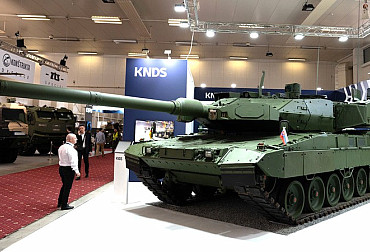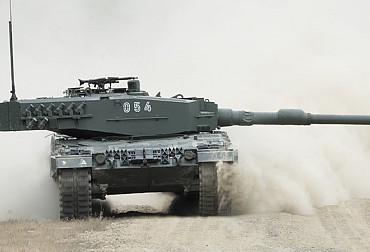First practical experience of Czech soldiers with German Leopard tank
Eight tank drivers and technicians of the Czech Army spent nearly a month on an initial retraining course for German Leopard tanks. The training took place at the German Army's centre in Munster near Hamburg and the Czech tankers tried driving in the field and on a roundabout. Fourteen Leopard 2 A4 tanks and one Bpz3 Büffel recovery vehicle were donated to the Czech Republic by Germany in return for military support to Ukraine.
Defence Minister Jana Černochová agreed on the donation with her German counterpart Christine Lambrecht this May. The delivery also includes an initial package of spare parts, ammunition and three years of service support from the supplier, which includes training of Czech soldiers.
 Picture: The training took place on a Leopard training tank, not on the original vehicle (see glass turret, double steering etc.) | Bundeswehr
Picture: The training took place on a Leopard training tank, not on the original vehicle (see glass turret, double steering etc.) | Bundeswehr
The course, which ran from 17 October to 11 November, consisted of a theoretical and practical part, with the Czech soldiers spending around eight hours a day on the training. "It was very similar to the courses in our country. During the theory, we got acquainted with driving and maintenance techniques, for example, and in practice we got to experience everything in real life on real tanks," says Sergeant First Class P.K., a member of the 73rd Tank Battalion Přáslavice. The Czech soldiers had four tanks and the same number of German instructors, and the training was conducted in German with the help of translators.
The inhabitants of the northern German town of Munster are mostly soldiers (several units of the German army are based there), and the training area is located just outside the town. The tankers are therefore used to moving here on normal roads, and their Czech colleagues have tried the same.
 Picture: Tank driver training | Bundeswehr
Picture: Tank driver training | Bundeswehr
"The basis of the training consisted of driving on public roads, which is possible with Leopard tanks because they are equipped with rubber tracks. We drove over railway crossings, overtook cyclists in places, let pedestrians through at crosswalks and passed oncoming traffic. A few times we even tried driving on a roundabout," the Czech soldier says with a smile, adding that at the stop sign it was necessary to be careful that the tank's barrel did not extend into the intersection.
The Czech Army is acquiring older but fully functional tanks, which originally came from the arsenal of the armed forces of Switzerland and Germany. According to Sergeant First Class P.K., they are comparable to the latest, so-called fourth modernisation of the T-72M4CZ tank, which the Práslavice garrison has in its armoury together with the first modernisation. According to him, retraining to the new vehicle will not be a problem for the Czech soldiers.
 Picture: Group photo from the initial retraining course for German Leopard tanks | Bundeswehr
Picture: Group photo from the initial retraining course for German Leopard tanks | Bundeswehr
"Both tanks are similar in many ways. For example, they have an automatic transmission and four forward speeds. The advantage of the Leopard over the T-72M4CZ is the system of counter-running tracks that turn the tank on the spot. The German vehicle also has a much simpler dashboard, while the T-72 has a number of communicators, alarm clocks and controls that the driver has to keep an eye on," added the Czech tanker.
 Picture: Eight Czech Army tank drivers and technicians spent nearly a month on the initial retraining course for German Leopard tanks | Bundeswehr
Picture: Eight Czech Army tank drivers and technicians spent nearly a month on the initial retraining course for German Leopard tanks | Bundeswehr
This course will be followed by a similar one, again for eight members of the Czech Army, with priority being given to those involved in driver training and instructors from the Vyškov Training Command – Military Academy. This initial training in Germany will be followed by more intensive combined training of Czech and German tankers in the Czech Republic.





















